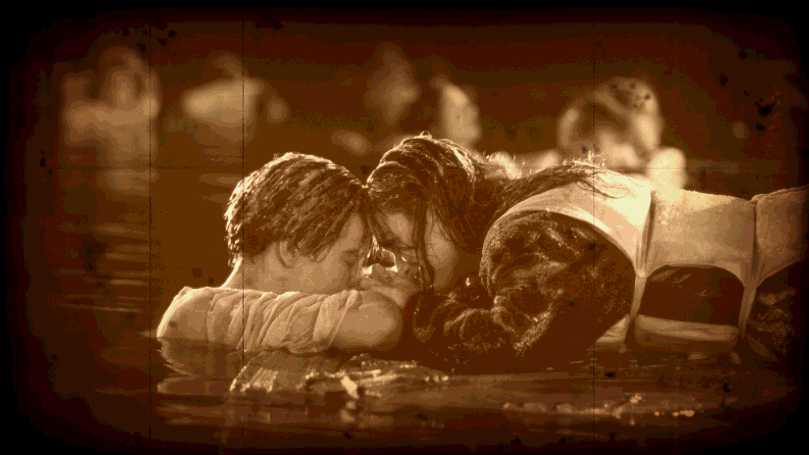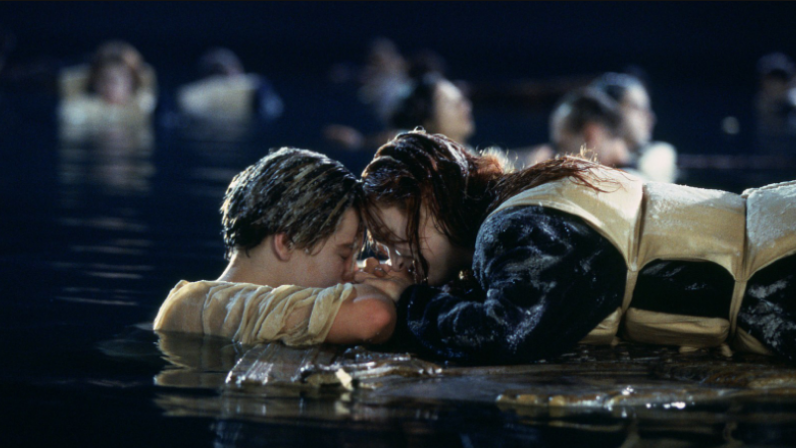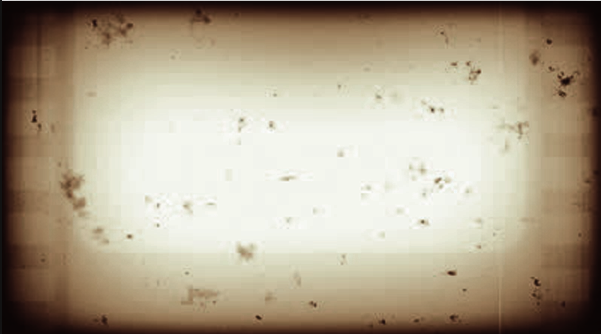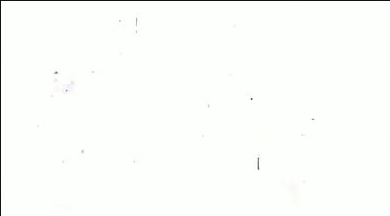Unity3D-Shader-复古电影荧幕特效
【旧博客转移 - 2015年12月6日 18:12】
今天用Shader做了一个复古荧幕效果,老电视机放映的感觉,写篇文章记录一下

原始图片:

没错,这就是电影《泰坦尼克号》的剧照。船撞到冰山上翻了,气温非常低,男主角杰克,找到了一块木板,让女主角睡在上面保住了性命,自己被冻成冰块沉入海底,还是蛮感人的。
实现原理就是用到几张特效图,加入一些抖动效果
1.晕影图(Vignette effect)

2.屏幕划痕Scratches和 灰尘污点Dust


Shader实现:
half2 mainTexUV = half2(i.uv.x, i.uv.y+(_RandomValue*_SinTime.z * 0.005)); fixed4 mainTex = tex2D(_MainTex, mainTexUV);
采样主纹理,UV值y加上了一个随机值,实现上下抖动的效果。
_SinTime是Unity内置的一个变量,用来获取一个-1到1范围的sin函数值
half2 scratchesUV = half2(i.uv.x + (_RandomValue * _SinTime.z * _ScratchesXSpeed), i.uv.y + (_RandomValue * _Time.x * _ScratchesYSpeed)); fixed4 scratchesTex = tex2D(_ScratchesTex, scratchesUV);
采样划痕纹理,这里的UV值,采用随机数乘以X,Y轴分别的速度,来实现屏幕随机位置的闪动效果,灰尘纹理也是一样的处理
//转成YIQ色彩空间,取出亮度值 fixed lum = dot(fixed3(0.299, 0.587, 0.114), mainTex.rgb); fixed4 finalColor = lum + lerp(_SepiaColor, _SepiaColor + fixed4(0.1f, 0.1f, 0.1f, 0.1f), _RandomValue);
这一步是把RGB颜色空间转换成YIQ颜色空间,YIQ色彩空间通常被电视系统所采用,在YIQ系统中,Y分量代表图像的亮度信息,I、Q两个分量则携带颜色信息,I分量代表从橙色到青色的颜色变化,而Q分量则代表从紫色到黄绿色的颜色变化。将彩色图像从RGB转换到YIQ色彩空间,可以把彩色图像中的亮度信息与色度信息分开,分别独立进行处理。
再加上一个棕褐色调_SepiaColor,这里用lerp函数做一个线性插值,实现明暗之间的渐变
fixed3 constantWhite = fixed3(1, 1, 1); finalColor = lerp(finalColor, finalColor * vignetteTex, _VignetteAmount); finalColor.rgb *= lerp(scratchesTex, constantWhite, _RandomValue); finalColor.rgb *= lerp(dustTex, constantWhite, (_RandomValue * _SinTime.z)); finalColor = lerp(mainTex, finalColor, _EffectAmount);
最后把颜色汇总,用一些线性插值实现渐变,然后把颜色值相乘得到最后的结果。返回给fragment着色器输出,就可以得到上面的效果。
完整Shader:
Shader "lijia/OldEffect" { Properties { //原图 _MainTex("MainTex", 2D) = "white" {} //晕影图 _VignetteTex("VignetteTex", 2D) = "white" {} _VignetteAmount ("Vignette Opacity", Range(0, 1)) = 1 //划痕 _ScratchesTex("ScratchesTex", 2D) = "white" {} _ScratchesXSpeed("ScratchesXSpeed", float) = 100 _ScratchesYSpeed("ScratchesYSpeed", float) = 100 //灰尘 _DustTex("DustTex", 2D) = "white" {} _DustXSpeed("_DustXSpeed", float) = 100 _DustYSpeed("_DustYSpeed", float) = 100 //老旧的褐色调 _SepiaColor("_SepiaColor", Color) = (1, 1, 1, 1) _RandomValue("RandomValue", float) = 1.0 _EffectAmount ("Old Film Effect Amount", Range(0, 1)) = 1 } SubShader { Tags{"RenderType" = "Opaque"} Pass { CGPROGRAM #pragma vertex vert #pragma fragment frag #include "UnityCG.cginc" sampler2D _MainTex; float4 _MainTex_ST; sampler2D _VignetteTex; sampler2D _ScratchesTex; sampler2D _DustTex; float _EffectAmount; float _RandomValue; float _VignetteAmount; float _ScratchesXSpeed; float _ScratchesYSpeed; float _DustXSpeed; float _DustYSpeed; fixed4 _SepiaColor; struct v2f { float4 pos : SV_POSITION; float2 uv : TEXCOORD0; }; v2f vert(appdata_base v) { v2f o; o.pos = mul(UNITY_MATRIX_MVP, v.vertex); o.uv = TRANSFORM_TEX(v.texcoord, _MainTex); return o; } fixed4 frag(v2f i): COLOR { //采样主纹理 uv.y值加上一些随机因素实现抖动的效果 _SinTime是Unity内置的变量 用来获取一个-1到1的正弦值 half2 mainTexUV = half2(i.uv.x, i.uv.y+(_RandomValue*_SinTime.z * 0.005)); fixed4 mainTex = tex2D(_MainTex, mainTexUV); fixed4 vignetteTex = tex2D(_VignetteTex, i.uv); half2 scratchesUV = half2(i.uv.x + (_RandomValue * _SinTime.z * _ScratchesXSpeed), i.uv.y + (_RandomValue * _Time.x * _ScratchesYSpeed)); fixed4 scratchesTex = tex2D(_ScratchesTex, scratchesUV); half2 dustUV = half2(i.uv.x + (_RandomValue * _SinTime.z * _DustXSpeed), i.uv.y + (_Time.x * _DustYSpeed)); fixed4 dustTex = tex2D(_DustTex, dustUV); //变成YIQ 值 fixed lum = dot(fixed3(0.299, 0.587, 0.114), mainTex.rgb); fixed4 finalColor = lum + lerp(_SepiaColor, _SepiaColor + fixed4(0.1f, 0.1f, 0.1f, 0.1f), _RandomValue); fixed3 constantWhite = fixed3(1, 1, 1); finalColor = lerp(finalColor, finalColor * vignetteTex, _VignetteAmount); finalColor.rgb *= lerp(scratchesTex, constantWhite, _RandomValue); finalColor.rgb *= lerp(dustTex, constantWhite, (_RandomValue * _SinTime.z)); finalColor = lerp(mainTex, finalColor, _EffectAmount); return finalColor; } ENDCG } } FallBack "Diffuse" }
扩展:
上面讲的是基于一张原图做的处理,如果我们想实现在动态内容上加上这种老电影效果呢?比如游戏中播放剧情的时候,在屏幕上加上一个老电影特效,提高带入感。
这时我们可以用混合模式

官方文档的解释
Blend DstColor Zero是乘以Color缓冲区的颜色的,而这个特效刚好是用到乘法
分了两个Pass来实现
第一个Pass先处理色调
Pass { Blend DstColor Zero CGPROGRAM #pragma vertex vert_img #pragma fragment frag #include "UnityCG.cginc" fixed4 _SepiaColor; float _RandomValue; fixed4 frag(v2f_img i): COLOR { fixed4 color = fixed4(0.299, 0.587, 0.114, 1); color = color + lerp(_SepiaColor, _SepiaColor + fixed4(0.1f, 0.1f, 0.1f, 0.1f), _RandomValue); return color; } ENDCG }
第二个Pass再把剩下的图片叠加上去,跟之前一样处理就行了。
fixed4 frag(v2f_img i): COLOR { fixed4 vignetteTex = tex2D(_VignetteTex, i.uv); half2 scratchesUV = half2(i.uv.x + (_RandomValue * _SinTime.z * _ScratchesXSpeed), i.uv.y + (_RandomValue * _Time.x * _ScratchesYSpeed)); fixed4 scratchesTex = tex2D(_ScratchesTex, scratchesUV); half2 dustUV = half2(i.uv.x + (_RandomValue * _SinTime.z * _DustXSpeed), i.uv.y + (_Time.x * _DustYSpeed)); fixed4 dustTex = tex2D(_DustTex, dustUV); fixed3 constantWhite = fixed3(1, 1, 1); fixed4 finalColor = fixed4(1, 1, 1, 1);//这里使用1,因为混合模式会乘Color缓冲的颜色 finalColor = lerp(finalColor, finalColor*vignetteTex, _RandomValue); finalColor.rgb *= lerp(scratchesTex, constantWhite, _RandomValue); finalColor.rgb *= lerp(dustTex, constantWhite, _RandomValue*_SinTime.z); return finalColor; }
感谢http://blog.csdn.net/candycat1992,读你的文章让我学到了很多知识
转载请注明出处: 李嘉的博客 - http://www.cnblogs.com/lijiajia



